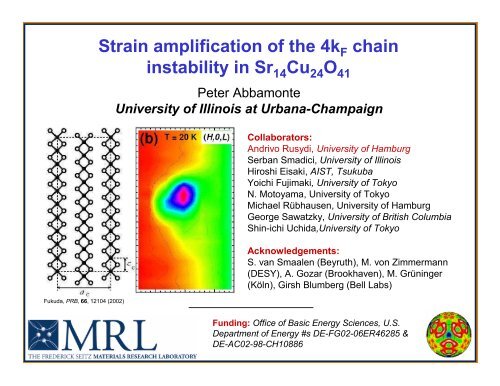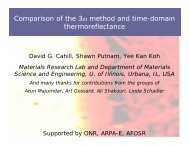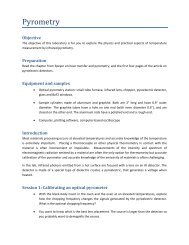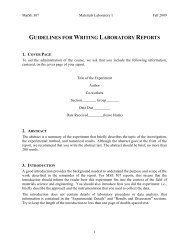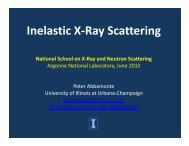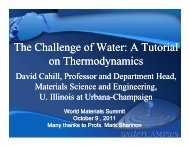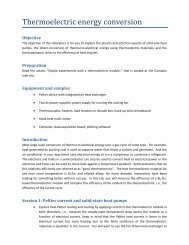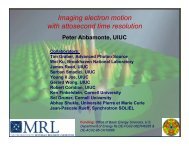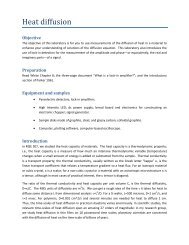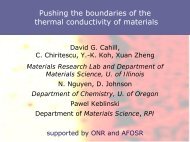Strain amplification of the 4k chain instability in Sr Cu O
Strain amplification of the 4k chain instability in Sr Cu O
Strain amplification of the 4k chain instability in Sr Cu O
Create successful ePaper yourself
Turn your PDF publications into a flip-book with our unique Google optimized e-Paper software.
<strong>Stra<strong>in</strong></strong> <strong>amplification</strong> <strong>of</strong> <strong>the</strong> <strong>4k</strong> F <strong>cha<strong>in</strong></strong><br />
<strong><strong>in</strong>stability</strong> <strong>in</strong> <strong>Sr</strong> 14 <strong>Cu</strong> 24 O 41<br />
Peter Abbamonte<br />
University <strong>of</strong> Ill<strong>in</strong>ois at Urbana-Champaign<br />
Fukuda, PRB, 66, 12104 (2002)<br />
Collaborators:<br />
Andrivo Rusydi, University <strong>of</strong> Hamburg<br />
Serban Smadici, University <strong>of</strong> Ill<strong>in</strong>ois<br />
Hiroshi Eisaki, AIST, Tsukuba<br />
Yoichi Fujimaki, University <strong>of</strong> Tokyo<br />
N. Motoyama, University <strong>of</strong> Tokyo<br />
Michael Rübhausen, University <strong>of</strong> Hamburg<br />
George Sawatzky, University <strong>of</strong> British Columbia<br />
Sh<strong>in</strong>-ichi Uchida,University <strong>of</strong> Tokyo<br />
Acknowledgements:<br />
S. van Smaalen (Beyruth), M. von Zimmermann<br />
(DESY), A. Gozar (Brookhaven), M. Grün<strong>in</strong>ger<br />
(Köln), Girsh Blumberg (Bell Labs)<br />
Fund<strong>in</strong>g: Office <strong>of</strong> Basic Energy Sciences, U.S.<br />
Department <strong>of</strong> Energy #s DE-FG02-06ER46285 &<br />
DE-AC02-98-CH10886
<strong>Sr</strong> 14-x Ca x <strong>Cu</strong> 24 O 41 (SCCO)<br />
Fukuda, PRB, 66, 12104 (2002)<br />
• Cha<strong>in</strong>s buckle to accommodate ladder:<br />
c ≈ 7c L ≈ 10c c<br />
1<br />
c = 27.3 Å<br />
• <strong>Sr</strong> 2+ , O 2– ⇒ <strong>Cu</strong> 2.25+<br />
isoelectronic to perovskite cuprates<br />
• 6 holes / formula unit. Most are <strong>in</strong> <strong>the</strong><br />
<strong>cha<strong>in</strong></strong>. 3<br />
• Conductivity governed by ladders 2<br />
<strong>Cu</strong>O 2<br />
<strong>Cu</strong> 2<br />
O 3<br />
• Sp<strong>in</strong> gap at all temperatures 4 : Pair<strong>in</strong>g<br />
1 Etrillard, Physica C, 403, 290 (2004); Braden, PRB, 69, 214426 (2004)<br />
2<br />
Osafune, PRL, 78, 1980 (1997)<br />
3 Nücker, PRB, 62, 14384 (2000); Piskunov, PRB, 72, 064512 (2005); Rusydi, PRB, 75, 10450 (2007)<br />
4 Carter, PRL., 77, 1378 (1996); Takigawa, PRB, 57, 1124 (1998); Matsuda, PRB, 56, 14499 (1997)
Sp<strong>in</strong> ladders<br />
t, J<br />
E. Dagotto, J. Riera, D. Scalap<strong>in</strong>o, Phys. Rev. B, 45, 5744 (1992)<br />
• Doped hole breaks a s<strong>in</strong>glet; costs energy J<br />
• No sp<strong>in</strong> gap<br />
• Holes b<strong>in</strong>d <strong>in</strong>to pairs, b<strong>in</strong>d<strong>in</strong>g energy ~J<br />
• Sp<strong>in</strong> gap restored ⇔ Pair<strong>in</strong>g<br />
• Superconductivity, ∆ ~ d x2-y2 M. Sigrist, PRB, 49, 12058 (1994)<br />
Unstable to <strong>the</strong> formation <strong>of</strong> “charge density waves”<br />
S. White, I. Affleck, D. Scalap<strong>in</strong>o, Phys. Rev. B, 65, 165122 (2002)<br />
• δ rational ⇒ holes “crystallize” <strong>in</strong>to <strong>in</strong>sulat<strong>in</strong>g CDW<br />
• δ irrational ⇒ metal with dynamic CDW correlations<br />
• Rem<strong>in</strong>iscent <strong>of</strong> ordered stripes vs. SC <strong>in</strong> High T c<br />
Tranquada, PRL, 78, 338 (1997)
Sp<strong>in</strong> ladders<br />
t, J<br />
E. Dagotto, J. Riera, D. Scalap<strong>in</strong>o, Phys. Rev. B, 45, 5744 (1992)<br />
• Doped hole breaks a s<strong>in</strong>glet; costs energy ~J<br />
• No sp<strong>in</strong> gap<br />
• Holes b<strong>in</strong>d <strong>in</strong>to pairs, b<strong>in</strong>d<strong>in</strong>g energy ~J<br />
• Superconductivity, ∆ ~ d x2-y2<br />
• Sp<strong>in</strong> gap restored ⇔ Pair<strong>in</strong>g<br />
M. Sigrist, PRB, 49, 12058 (1994)<br />
Unstable to <strong>the</strong> formation <strong>of</strong> “charge density waves”<br />
S. White, I. Affleck, D. Scalap<strong>in</strong>o, Phys. Rev. B, 65, 165122 (2002)<br />
• δ rational ⇒ holes “crystallize” <strong>in</strong>to <strong>in</strong>sulat<strong>in</strong>g CDW<br />
• δ irrational ⇒ metal with dynamic CDW correlations<br />
• Rem<strong>in</strong>iscent <strong>of</strong> ordered stripes vs. SC <strong>in</strong> High T c<br />
Tranquada, PRL, 78, 338 (1997)
<strong>Sr</strong> 14-x Ca x <strong>Cu</strong> 24 O 41 (SCCO)<br />
• x = 13.6 ⇒ superconductivity T c = 12 K at<br />
P = 3 GPa 1<br />
• x = 0 ⇒ <strong>in</strong>sulat<strong>in</strong>g with a CDW 2,3,4<br />
1<br />
M. Uehara, et. al.,<br />
J. Phys. Soc. Jpn.,<br />
65, 2764 (1996)<br />
• Exhibits both predicted phases for ladder.<br />
• Can tune between CDW and SC <strong>in</strong> one<br />
system<br />
3 Blumberg, et. al., Science, 297, 584 (2002)<br />
1<br />
Uehara, J. Phys. Soc. Jap., 65, 2764 (1996)<br />
2<br />
Gorshunov, PRB, 66, 60508 (2002)<br />
4 Vuletić, PRL, 90, 257002 (2003)
Cha<strong>in</strong> buckl<strong>in</strong>g <strong>in</strong> <strong>Sr</strong> 14 <strong>Cu</strong> 24 O 41<br />
Z. Hiroi, PRB, 54, 15849 (1996)<br />
(1,-1,0) zone<br />
Fukuda, PRB, 66, 12104 (2002)<br />
c = 27.3 Å<br />
Conjecture: Interplay between<br />
<strong>cha<strong>in</strong></strong> buckl<strong>in</strong>g and a <strong>cha<strong>in</strong></strong> CDW
X-ray & Neutron scatter<strong>in</strong>g – <strong>cha<strong>in</strong></strong> CDW?<br />
Charge density wave <strong>in</strong> <strong>the</strong> <strong>cha<strong>in</strong></strong> layer<br />
T. Fukuda, PRB, 66, 12104 (2002)<br />
D. E. Cox, PRB, 57, 10750 (1998)<br />
Matsuda, PRB, 54, 12199 (1996)<br />
Matsuda, PRB, 56, 14499 (1997)
X-ray & Neutron scatter<strong>in</strong>g – <strong>cha<strong>in</strong></strong> CDW?<br />
Charge density wave <strong>in</strong> <strong>the</strong> <strong>cha<strong>in</strong></strong> layer<br />
T. Fukuda, PRB, 66, 12104 (2002)<br />
D. E. Cox, PRB, 57, 10750 (1998)<br />
Matsuda, PRB, 54, 12199 (1996)<br />
Matsuda, PRB, 56, 14499 (1997)<br />
All just Bragg peaks from <strong>the</strong> structure<br />
S. van Smaalen, PRB, 67, 26101 (2003)
X-ray & Neutron scatter<strong>in</strong>g – <strong>cha<strong>in</strong></strong> CDW?<br />
Charge density wave <strong>in</strong> <strong>the</strong> <strong>cha<strong>in</strong></strong> layer<br />
T. Fukuda, PRB, 66, 12104 (2002)<br />
D. E. Cox, PRB, 57, 10750 (1998)<br />
Matsuda, PRB, 54, 12199 (1996)<br />
Matsuda, PRB, 56, 14499 (1997)<br />
All just Bragg peaks from <strong>the</strong> structure<br />
S. van Smaalen, PRB, 67, 26101 (2003)<br />
Higher harmonics appear only at low T<br />
Etrillard, Physica C, 403, 290 (2004)<br />
Braden, PRB, 69, 214426 (2004)
X-ray & Neutron scatter<strong>in</strong>g – <strong>cha<strong>in</strong></strong> CDW?<br />
Charge density wave <strong>in</strong> <strong>the</strong> <strong>cha<strong>in</strong></strong> layer<br />
T. Fukuda, PRB, 66, 12104 (2002)<br />
D. E. Cox, PRB, 57, 10750 (1998)<br />
Matsuda, PRB, 54, 12199 (1996)<br />
Matsuda, PRB, 56, 14499 (1997)<br />
All just Bragg peaks from <strong>the</strong> structure<br />
S. van Smaalen, PRB, 67, 26101 (2003)<br />
Higher harmonics appear only at low T<br />
Etrillard, Physica C, 403, 290 (2004)<br />
Braden, PRB, 69, 214426 (2004)<br />
Harmonics come from <strong>the</strong>rmal contraction<br />
M. v. Zimmermann, PRB, 73, 115121 (2006)<br />
Still unclear if <strong>the</strong>re is a CDW <strong>in</strong> <strong>the</strong> <strong>cha<strong>in</strong></strong> <strong>of</strong> <strong>Sr</strong> 14<br />
<strong>Cu</strong> 24<br />
O 41
Resonant s<strong>of</strong>t x-ray scatter<strong>in</strong>g (RSXS)<br />
valence band<br />
• Resonant elastic scatter<strong>in</strong>g, E i = E s<br />
– not RIXS<br />
• Periodic DOS modulation gives<br />
“Bragg” peak<br />
• | g(k,ω) | 2 where ω = E - E F<br />
• Same as STS for V > 0<br />
E i<br />
E s = E i<br />
Hanaguri, Nature,<br />
Core level<br />
430, 1001 (2004)<br />
Bulk-sensitive → can study anyth<strong>in</strong>g (214’s, heterostructures)<br />
Full T-dependence → 18 K < T < 500 K (push<strong>in</strong>g to 12 K)<br />
Not much k → Can reach (π,0) <strong>in</strong> cuprates but not (π,π)<br />
Radiative broaden<strong>in</strong>g ~ 200 meV
Unoccupied density <strong>of</strong> states (k=0)<br />
O K edge (1s → 2p) <strong>Cu</strong> L edge (2p → 3d)<br />
•, • <strong>Sr</strong> 14<br />
<strong>Cu</strong> 24<br />
O 41<br />
(SCO)<br />
δ c<br />
= 0.32 1 or δ c<br />
=0.5 2<br />
δ L<br />
= 0.2 1 or δ L<br />
=0.07 2<br />
• La 6<br />
Ca 8<br />
<strong>Cu</strong> 24<br />
O 41<br />
(LCCO)<br />
δ c<br />
= 0.056 3<br />
δ L<br />
= 0 3<br />
1<br />
A. Rusydi, PRB, 75, 104510 (2007), 2 N. Nücker, PRB, 62, 14384 (2000), 3 A. Rusydi, cond-mat/0611730
“Hole crystal” <strong>in</strong> <strong>the</strong> ladder<br />
T=28K<br />
Abbamonte, Nature, 431, 1078 (2004)<br />
T=28K<br />
• Density <strong>of</strong> states modulation: A Wigner crystal<br />
• L L = 0.200 ± 0.009 r. l. u. ⇒ λ = 5.00 ± 0.24 c L<br />
• Commensurate with Ladder: Does not <strong>in</strong>dex to<br />
27.3 Å unit cell.
“Hole crystal” <strong>in</strong> <strong>the</strong> ladder<br />
OK edge <strong>in</strong>tensity<br />
T = 20 K<br />
Forms only on<br />
rational fractions.<br />
τ<br />
τ<br />
1/3<br />
1/5<br />
= 1.652 =<br />
5<br />
3<br />
U ~ 1/R<br />
Pair density wave:<br />
Tesanovic, PRL, 93, 217004 (2004)<br />
Chen, PRL, 93, 187002 (2004)<br />
Rusydi, PRL, 97, 016403 (2006)
Everyth<strong>in</strong>g makes sense but …<br />
What about <strong>the</strong> <strong>cha<strong>in</strong></strong>?
Cha<strong>in</strong> and ladder orders<br />
A. Rusydi, cond-mat/0611730<br />
Z. Hiroi, et. al., PRB, 54, 15849 (1996)
Cha<strong>in</strong> and ladder orders<br />
A. Rusydi, cond-mat/0611730<br />
Z. Hiroi, et. al., PRB, 54, 15849 (1996)
Cha<strong>in</strong> and ladder orders<br />
A. Rusydi, cond-mat/0611730<br />
Z. Hiroi, et. al., PRB, 54, 15849 (1996)
Temperature dependence
Strange energy dependence<br />
x40
Separat<strong>in</strong>g charge and stra<strong>in</strong> with RXS<br />
P. Abbamonte, PRB, 74, 195113 (2006)<br />
Structure factor<br />
Form factor<br />
Absorption related to f(ω)<br />
<strong>Stra<strong>in</strong></strong> scatter<strong>in</strong>g follows:<br />
Charge scatter<strong>in</strong>g follows:<br />
RXS l<strong>in</strong>e shape gives<br />
W = v 0<br />
/u 0<br />
and phase φ<br />
W ~ 0 Supermodulation (Bragg)<br />
W ~ 1 A -1 Peierls CDW <strong>in</strong> K 0.3<br />
MoO 3<br />
W ~ 10 A -1 “stripes” <strong>in</strong> LBCO
Lattice and hole form factors
Fits<br />
<strong>Sr</strong> 14<br />
<strong>Cu</strong> 24<br />
O 41<br />
W = 1.13 Å -1<br />
φ= -23.1º<br />
La 6<br />
Ca 8<br />
<strong>Cu</strong> 24<br />
O 41<br />
W LCCO<br />
= 0.065 Å -1<br />
φ LCCO<br />
= -90.1<br />
Q = n c<br />
<strong>4k</strong> F modulation<br />
stabilized by<br />
supermodulation
Fits<br />
lattice<br />
holes<br />
<strong>Sr</strong> 14<br />
<strong>Cu</strong> 24<br />
O 41<br />
W = 1.13 Å -1<br />
φ= -23.1º<br />
La 6<br />
Ca 8<br />
<strong>Cu</strong> 24<br />
O 41<br />
W LCCO<br />
= 0.065 Å -1<br />
φ LCCO<br />
= -90.1<br />
Q = n c<br />
<strong>4k</strong> F modulation<br />
stabilized by<br />
supermodulation<br />
Interference “dip”
The Upshot<br />
• LCCO has a simple misfit supermodulation with period<br />
27.3 Å. q = 0.3 r.l.u. commensurate<br />
• Add holes (δ c ~ 0.3) → Supermodulation amplifies &<br />
stabilizes <strong>4k</strong> F <strong><strong>in</strong>stability</strong> <strong>of</strong> <strong>the</strong> <strong>cha<strong>in</strong></strong><br />
• <strong>4k</strong> F <strong><strong>in</strong>stability</strong> feeds back, shift<strong>in</strong>g supermodulation to<br />
<strong>in</strong>commensurate value q = 0.318 r.l.u.
Conclusions<br />
• RSXS allows determ<strong>in</strong>ation <strong>of</strong> W, φ<br />
• <strong>Sr</strong> 14 <strong>Cu</strong> 24 O 41 has two dist<strong>in</strong>ct, coexist<strong>in</strong>g charge density waves<br />
1. Ladder HC is ma<strong>in</strong>ly electronic, W ~ ∞ (immeasurably large)<br />
2. Cha<strong>in</strong> CDW is <strong>4k</strong> F stabilized by misfit stra<strong>in</strong>, W = 1.13 Å -1<br />
(W = 0.065 Å -1 if you take <strong>the</strong> holes out)<br />
• Transport is an amalgem <strong>of</strong> both<br />
• A CDW can form by stra<strong>in</strong><strong>in</strong>g a sample <strong>in</strong> <strong>the</strong> right way.
Fits<br />
W SCO<br />
= 1.13 Å -1 , φ SCO<br />
= -23.1º
Resonant s<strong>of</strong>t x-ray scatter<strong>in</strong>g (RSXS)<br />
• 1.2 m vacuum chamber: Pumped with Turbos and TSPs, 2 × 10 -9 mbar<br />
• Diffractometer: 10 motor axes work<strong>in</strong>g <strong>in</strong> a 6-circle geometry, <strong>in</strong>-vacuum<br />
step motors, ceramic bear<strong>in</strong>gs, vacuum lubricants.<br />
• Photon count<strong>in</strong>g detector: Channeltron, brak<strong>in</strong>g voltages, Au/CsI cathode<br />
• Helium cryostat: Indirect cool<strong>in</strong>g with copper braids (OFHC), T=18 K<br />
• 5 Tesla Magnet: Under commission<strong>in</strong>g.<br />
• <strong>Cu</strong>rrent: NSLS X1B; Forthcom<strong>in</strong>g: APS Sector 28
Resonance pr<strong>of</strong>ile or |g(k,ω)| 2<br />
Supermodulation <strong>in</strong> Bi 2<br />
<strong>Sr</strong> 2<br />
Ca<strong>Cu</strong> 2<br />
O 8+δ<br />
ZR<br />
s<strong>in</strong>glets<br />
McElroy, Nature, 422, 592 (2003)
Quantum melt<strong>in</strong>g<br />
“Melt<strong>in</strong>g”<br />
Wigner<br />
crystal<br />
L L = 1/3: ξ c<br />
= (1580 ± 70) Å and ξ a<br />
= (1615 ± 70) Å<br />
L L = 1/5: ξ c<br />
= (255 ± 40) Å and ξ a<br />
= (274 ± 40) Å<br />
Interaction strength grows with decreas<strong>in</strong>g hole spac<strong>in</strong>g
Spectroscopic details<br />
Note core<br />
level shift
Correlation with metal-<strong>in</strong>sulator transition<br />
Kojima, J. Elect. Spect.<br />
Rel. Phen., 237, 117<br />
(2001)<br />
Note this<br />
phase<br />
boundary.
Structural characterization<br />
• Gra<strong>in</strong> broken from same sample as <strong>cha<strong>in</strong></strong> studies<br />
• All 603 reflections <strong>in</strong>dex to known structure<br />
• 198 arise from <strong>in</strong>commensurate structure (<strong>cha<strong>in</strong></strong> buckl<strong>in</strong>g)
Oxygen stoichiometry
Self-absorption effects


